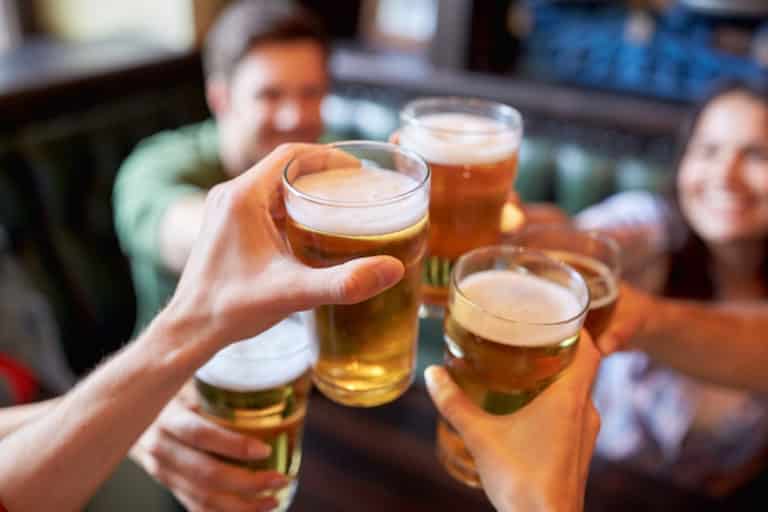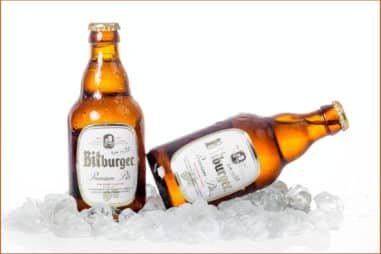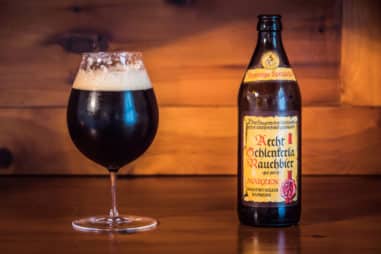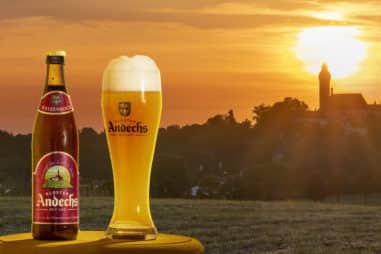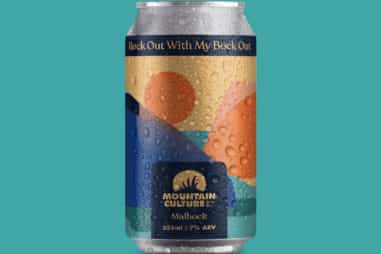If you’re a haze bro who loves a good ol’ juice bomb, you’ll love what a session IPA beer has to offer. But of course, hopheads are more than welcome to join the wort party.
In this guide, you’ll learn what Session IPA beer is, what makes them different from regular IPAs, and how it’s brewed.
What Does Session IPA Mean?
Session IPAs take the concept of session beer and regular IPA, so it’s something of a low-gravity beer.
You’re probably past the IPA 101 stage, but here’s a quick refresher:
- Session Beer: Beer you can drink more than 1 pint (roughly half a liter) without feeling satiated.
- IPA: Stands for India Pale Ale. What separates an IPA from any other ale is the addition of hops. This gives IPAs their distinct “hoppy” beer flavor and floral or citrusy characteristics.
Bring these two together and you get a session IPA — a session beer with the hop intensity and flavor of a regular IPA.
Why Are They Called Session IPAs?
Session IPAs date back to World War I when drinking on the job wasn’t *ahem* problematic. Workers were allowed two 2-hour drinking sessions (4 hours) per workday. Now, for the average hophead, drinking a stout, porter, or even regular IPA would make you feel too full or drunk. This called for a beer that wouldn’t make workers feel too full.
Think of it this way: a drinking session that could last for most of your day without the trouble of blackouts and drunk bar fights. And so… Session IPAs came to be!
What Makes an IPA a Session IPA?
There are 3 qualities that make an IPA a Session IPA:
- Hop Flavor. You still get all the hop flavor and floral characteristics you would find in a regular IPA.
- Sessionable. Beer light enough to drink more than 1-2 pints (1/2 to 1 liter) without passing out.
- ABV (Alcohol By Volume). Session IPAs have a lower ABV than a regular IPA (more on this in the next section).
What ABV Is a Session IPA?
Session IPAs have an ABV range below 5% and generally range between 3.8% to 4.5%, which begs the question…
Does a 1% to 1.5% difference make a big difference in alcohol consumption? If you’re drinking a session IPA at 4% compared to another IPA at 5%, does this affect your body significantly?
For this example, remember these two facts first:
- In a 350 ml (11.83 oz) 4% ABV IPA beer, there are 1.4 units of alcohol.
- In a 350 ml (11.83 oz) 5% ABV IPA beer, there are 1.8 units of alcohol.
For this hypothetical example, assume you drink one beer per hour.
How Your Body Processes 4% ABV Beer
After your first 4% ABV beer, your body processes 1 unit of alcohol while the remaining 0.4 units of alcohol stay in your body and give you a tipsy feeling.
After your second bottle, 0.8 units of alcohol remain, and on your third, 1.2 units.
How Your Body Processes 5% ABV Beer
For a 5% ABV beer, your body processes 1 unit of alcohol while 0.8 units of alcohol stay in your body. After the second bottle, 1.6 units of alcohol remain, and on your third, 2.4 units.
After 3 bottles of 5% ABV beer, your body has double the amount of alcohol than a 4% ABV beer. The point is a 1% to 1.5% difference makes a significant difference and could get you drunk faster.
This brings it back to Session IPAs and Regular IPAs.
Several factors affect how fast you get drunk. However, the example shown above is one indication that a lower ABV doesn’t get you drunk as fast compared to a higher ABV of regular IPAs in the 5% to 7.8% range.
What Is the Difference Between a Session IPA and a Regular IPA?
The most noticeable difference between a Session IPA and Regular IPA is the ABV: Session IPAs have a lower ABV (less than 5%) than Regular IPAs.
Here’s a simple way to illustrate the differences between the two:
- Session IPA: You can have a 6-pack session and not get hammered.
- Regular IPA: 6 pack session on barbecue night? Expect burnt sausages and steak.
Other not-so-obvious differences include the following:
- Session IPAs have lesser malt and hops than Regular IPAs.
- Some say Session IPAs taste more hoppy and yet aren’t as bitter as Regular IPAs.
- Generally a lighter alternative to regular IPAs.
What Is the Difference Between Session IPA and Pale Ale?
Pale Ales have more malt/hop flavor than Session IPAs and overall, Pale Ales deliver more balance.
What Does Session IPA Taste Like?
It depends on the hops used, but generally, Session IPAs deliver citrus, floral, and fruity characteristics.
What one can expect from a Session IPA is these beers don’t tend to be too much of anything, meaning it’s not too malty, not too bitter, and not too hoppy.
In terms of body, Session IPAs are lighter-bodied compared to regular IPAs. It’s worth noting that taste is subjective be it a lager or ale.
If you’re curious to learn more about what Session IPAs taste like, the next section covers examples of Session IPAs and their notes.
What Is a Good Session IPA?
Founders All Day IPA is one example of a good Session IPA. Founders is the gold standard that every other session beer compares itself to.
Although, Founders All Day IPA has a slightly higher ABV than most Session IPAs coming in at 4.9%. As for its tasting notes, expect zesty grapefruit, ripe oranges, and a floral hoppy flavor.
Another good Session IPA worth mentioning follows the New England Style Session IPA. This style packs a solid hoppy punch but it’s also extremely refreshing and fruity to taste.
Two great New England Style Session IPAs are Small Green Everything by Other Half and Baby Genius by Bissell Brothers.
Other Session IPAs Worth Trying
Fourpure Hemisphere
- ABV: 4.2%
- Tasting Notes: Tropical flavors and soft bitterness
Lagunitas DayTime
- ABV: 4%
- Tasting Notes: Slightly grassy, lime zest, and red apple peel; light hop flavor
Stone Brewing Stone Go To
- ABV: 4.5%
- Tasting Notes: Citrus, melon, and intense peach flavors; dry, bitter finish
Omnipollo Arzachel
- ABV: 3.5%
- Tasting Notes: Orange, pineapple, mandarin, and grapefruit zest; bittersweet hoppy finish
Moor Beer Company Revival Pale Bitter
- ABV: 3.8%
- Tasting Notes: Citrus, lime, grapefruit, and orange flavor; biscuity maltiness and bitter finish
Anchor Steam
- ABV: 4.9%
- Tasting Notes: Pine, floral, ripe tangerine and a hint of bread; caramel maltiness and piney hop finish
Oskar Blues Pinner
- ABV: 4.9%
- Tasting Notes: Mint, tropical fruits, vanilla, and caramel sweetness
Jack Abby’s Post Shift
- ABV: 4.9%
- Tasting Notes: Honey, earthy grassy, and lemon citrusy flavor with a touch of lightly toasted bread
Is Session IPA Gluten-Free?
Session IPAs are not originally brewed as gluten-free. However, there are a few brewing companies that offer gluten-free Session IPAs.
How is Gluten-Free Session IPA Brewed?
Back in the day, brewers would use sorghum, millet, and rice instead of wheat or barley to brew gluten-free Session IPAs.
Today, brewers use other gluten-free grains like corn, buckwheat, rice, and millet instead of sorghum due to its sour flavor.
Here are a few gluten-free Session IPAs you can try today:
- Free From Beer Co Gluten Free Session IPA
- Thornbridge AM:PM Session IPA
- Stone Brewing Stone Delicious IPA
What Qualifies as a Session IPA?
The main qualification for a Session IPA is the ABV or in other words, lower alcohol by volume content — ideally 3.5% to 4.8%.
The reason is that brewing a Session IPA with an ABV above 5% would no longer make it sessionable. Instead, you would get a regular IPA.
Other essential qualifications:
- Use the Right Type of Malts. You use fewer malts and grains when brewing a Session IPA. Since fewer malts are used, there’s a risk that your beer leans more towards the hops and the result is a beer that lacks sweetness and balance.
- Don’t Add Too Many Dry Hops. Adding too many dry hops destroys the balance of your beer.
Who Makes Kirkland Citra Session IPA?
For those who have tried Kirkland’s Citra Session IPA, you might have thought maybe Costco would have their own Kirkland brewery.
A few threads on Reddit, BeerAdvocate, and Mashed reveal Kirkland’s Citra Session IPA along with Kirkland’s line of beers and craft beers were made in 2 breweries:
- Hopfen Und Malz Brewing Co. (located at San Jose brewery Gordon Biersch)
- Bricks and Barley Brewing Company (located at Steven’s Point Wisconsin)
How to Brew Session IPA
The general brew process for a Session IPA is as follows:
- Do a Single Infusion mash at 160°F (71.1°C) for 60 minutes. Once done, add your sparge water. (the standard ratio is 1:1.5, so if you added 4 gallons (15 L) of mash, add 6 gallons (22.7 L) of sparge water)
- Bring your wort to a boil. Make sure to set the timer
- Add your 30-minute hop addition (as soon as your timer shows you have 30 minutes left for the boiling process, add in your 30-minute hops)
- Turn off the heat
- Chill your wort for about 20 minutes
- Add your whirlpool hops and keep the temperature between 160°F (71.1°C) to 170°F (77°C) for 30 minutes
- Start chilling process of your wort to 68°F (20°C)
- Transfer your cooled wort to a sanitized or clean fermenter. Make sure to leave the trub and hop matter
- Pitch the yeast
- Ferment the yeast at 68°F (20°C) for 5 days
- Add in your dry hops, and wait for 3 to 4 days (It’s crucial to add in your dry hops 3 to 4 days before packaging your beer)
- Cold crash for 24 hours to improve the clarity of your beer
- Transfer your beer to a clean keg preferably using the closed transfer process
- Add priming sugar to carbonate your beer
- Formula: for every 5 gallons (19L) of beer, use ⅔ cup (158 ml) of table sugar, ¾ cups (177.4 ml) of corn sugar, and 1 ¼ cup (296 ml) of dry malt extract)
- Seal your keg at 32°F (0°C) for 1 to 2 weeks. (Aim for 2.5 volumes of CO2 for ideal carbonation)
Brew Session IPA FAQs
What Fermentables Should You Use for Session IPA?
You can start with 7 lb. (3.18 kg) of 2-row malt, 1.5 lb (0.68 kg) of malted wheat, and 1.5 lb (0.68 kg) of flaked oats.
If you want more sweetness and color, you can add light crystal malt (should be less than 3%).
Why add flaked oats? Its main purpose is to soften your palate and to give your beer a better silky mouthfeel and creaminess.
What Are Good Hop Varieties to Use for Session IPA?
For Session IPA brewing, it’s preferable to stick to classic American hop varieties such as Simcoe, Cascade, and Centennial.
If you want to experiment with other hop varieties, Citra, Mosaic, Enigma, and Cashmere are all great flavor options.
What Is the Ideal Water Profile for Session IPAs?
This depends on the water profile in your area, but what you should look out for are chlorine and chloramine. These are two minerals you want to remove before you start the brewing process.
You can use a Campden tablet or you can simply use either distilled or reverse osmosis (RO) water.
Carbon filtered water is also a good choice. Here is a good water profile to follow:
- Chloride: 80 ppm
- Magnesium: 20 ppm
- Calcium: 20 ppm
- Sulfates: 60 ppm
- Mash pH: 5.2
What Is a Good Starter Yeast for Session IPA Brewing?
You won’t find a lot of good yeast for Session IPA brewing; however, it’s preferred to go with SafAle US-05 as a good starter yeast.
How Long to Ferment Session IPA?
The fermentation process for a Session IPA normally takes 5 to 7 days. Some recipes might go as far as 10 days; however, 5 to 7 is a good standard to follow as a beginner.
The average fermentation process takes 2 to 3 weeks.
For Session IPAs, the fermentation should be shorter than average. The reason is that the longer the fermentation, the more sugars are converted into alcohol.
That means a longer fermentation time inevitably leads to beer with higher alcohol content.

